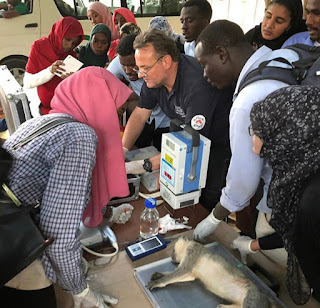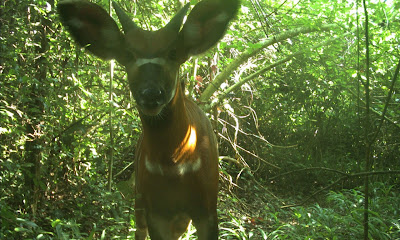NOTE from Sudan Watch Editor: Well done Samy for reporting on animals in need. I hope the report is followed up on with news of how the animals in Khartoum are surviving. Are they being cared for? Does anyone care?
At the start of the Sudan crisis I donated to the British Red Cross to help the people of Sudan and South Sudan. I wish Red Cross could help animals too.
Report from Chronograph.com
By SAMY MAGDY, Associated Press
Wednesday 10 May 2023
Updated: May 10, 2023 4:06 a.m.
Fears over scores of zoo animals caught in Sudan crossfire
ASWAN, Egypt (AP) — Dozens of zoo animals in Sudan's capital — including an elderly crocodile, parrots and giant lizards — are feared dead after street battles between the country's rival forces made the location unreachable.
At least 100 animals, all kept inside enclosures, will have gone more than three weeks without food or water, said Sara Abdalla, the head zoologist at the zoo, which is part of the Sudan Natural History Museum.
Millions of people in Sudan have endured shortages of food, water and medicines after the conflict halted the most basic services. But as the sounds of explosions ring across the Sudanese capital of Khartoum, Abdalla has been wracked with worry over her animal charges, particularly those that are increasingly rare to find in their natural habitats in Sudan.
“I feel a great deal of misery and sadness, as well as helplessness,” she said in a telephone interview from Khartoum. “I have assumed that we lost the birds and mammals.”
The zoo is home to species including an African grey parrot, a vervet monkey, giant lizards known as Nile monitors, a desert tortoise, a horned viper snake and a Nubian spitting cobra. Prior to the fighting, these were all fed twice a day. But the last time they received their meals and for some, medications, was on April 14, the day before fighting broke out, according to Abdalla.
The conflict, which capped months of tensions between Sudan’s rival generals, pits the Sudanese military, led by Gen. Abdel-Fattah Burhan, who is the head of the ruling sovereign council, against the powerful paramilitary Rapid Support Forces. The RSF is commanded by Burhan’s deputy on the council, Gen. Mohamed Hamdan Dagalo. Abdalla said neither has heeded appeals to allow access to the zoo.
The conflict has turned much of Khartoum and the adjacent city of Omdurman into a battlefield, with both sides using heavy weapons, including artillery and airstrikes, inside urban areas. The urban combat has badly damaged infrastructure and properties and poses great risk to civilians trying to move in the city streets.
Residents fleeing the capital have described seeing bodies littering sidewalks and central squares, particularly in areas not far from the museum. Roughly 500 civilians have been killed in the fighting so far, according to Sudan's doctors' syndicate, though the true number of dead is believed to be higher.
The zoo, which is housed inside the University of Khartoum, is one of the oldest in Sudan. The facility was established about a century ago as part of Gordon Memorial College, an educational institution built in the early 1900s when Sudan was a part of the British empire. It was annexed to the University of Khartoum two years after Sudan won independence in 1956.
Its current location is close to the military’s headquarters, where fighting has been heavy, preventing access to the museum.
Abdalla, who teaches zoology at the University of Khartoum, began working at the museum in 2006, and was appointed director of the facility in 2020. It was a job she had dreamed of since she visited the museum as a child. Now, trapped at her home in southern Khartoum with her husband and their two children — 9-year-old Yara, and 4-year-old Mohamed — she worries about the animals that have already survived years of unrest, economic collapse and pandemic lockdowns.
Neither the military nor the RSF responded to requests for comment on the plight of the animals and their caretakers.
“Unless someone released the animals early on when the clashes started, I don’t see how any would or could have survived for over two weeks with no care,” said Kamal M. Ibrahim, a biology professor at Southern Illinois University, Carbondale in an email. He is familiar with the museum and its work, having graduated from the University of Khartoum and spending a sabbatical there.
The museum documents the wildlife of Sudan and its neighbor South Sudan. The facility serves both scientists and the general public. It also contains hundreds of valuable preserved animal specimens, some of which are now extinct, according to Abdalla.
Both Ibrahim and Abdalla are particularly worried about a Nile crocodile, raised from an egg at the facility since 1971. Abdalla said the crocodile was on a regimen of medicine and vitamins due advanced age. The crocodiles are increasingly rare to find in the Blue and White Nile rivers that cut their way through the country.
“It could have fared better if released from its enclosure,” Ibrahim said.
In this undated photo released by Sara Abdalla, director of the zoological park at the University of Khartoum, a vervet monkey is pictured inside its enclosure in Khartoum, Sudan. The animal is one of dozens feared dead or missing inside the park in Sudan's capital after intense fighting made the location unreachable. (Sara Abdalla via AP AP
In this undated photo released by Sara Abdalla, director of the zoological park at the University of Khartoum, a Nile crocodile is pictured inside its enclosure in Khartoum, Sudan. The 50-year-old reptile was raised in captivity from an egg, and is one of dozens feared dead or missing inside the park in Sudan's capital after intense fighting made the location unreachable. (Sara Abdalla via AP) AP
In this undated photo released by Sara Abdalla, director of the zoological park at the University of Khartoum, a Nubian spitting cobra is pictured inside its enclosure in Khartoum, Sudan. The animal is one of dozens feared dead or missing inside the park in Sudan's capital after intense fighting made the location unreachable. (Sara Abdalla via AP) AP
In this undated photo released by Sara Abdalla, director of the zoological park at the University of Khartoum, a carpet viper is pictured inside its enclosure in Khartoum, Sudan. The animal is one of dozens feared dead or missing inside the park in Sudan's capital after intense fighting made the location unreachable. (Sara Abdalla via AP) AP
In this undated photo released by Sara Abdalla, director of the zoological park at the University of Khartoum, a Nile monitor lizard is pictured inside its enclosure in Khartoum, Sudan. The animal is one of dozens feared dead or missing inside the park in Sudan's capital after intense fighting made the location unreachable. (Sara Abdalla via AP) AP
View original: https://www.chron.com/news/world/article/fears-over-scores-of-zoo-animals-caught-in-sudan-18090097.php
[Ends]















